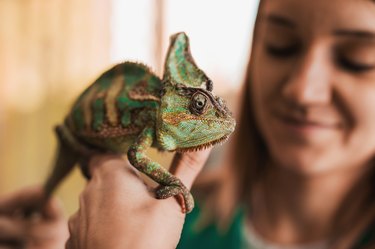
Chameleons can morph from green to turquoise to black, and a few shades in between, so there's never a dull moment with these changeable pets. To keep their colors bright, chameleons need to eat a diet that is primarily comprised of insects, but it can be balanced out with a few select fruits and vegetables. Keep in mind that chameleons have complex needs and can be stressed by the wrong food or a lot of handling, so they need more dedicated care than some other reptile pets.
Kinds of chameleons
Video of the Day
Pet chameleons should be purchased from a reputable pet store rather than captured from the wild. The veiled chameleon is often recommended. Males can grow up to a foot long. This species lives for about six to eight years. The smaller Senegal chameleon is highly sensitive to changes in its environment and has a lifespan of just five years. The horned Jackson chameleon lives up to 10 years and grows more colorful with age.
Video of the Day
The best chameleon diet
Chameleons happily live on a diet of live crickets, meal worms, roaches, and other insects. Silk worms and wax worms are favorites, but because they are fatty should not comprise a majority of a chameleon's food. Some chameleons also eat baby mice. Chameleons' long, sticky tongues swiftly flick out to catch prey and convey it into their throat.
A baby chameleon will need smaller-sized food than an adult. Small crickets, called pin head crickets, and fruit flies are best until they are able to eat adult portions.
While they are primarily carnivores, some chameleons, particularly veiled chameleons, also enjoy chomping on fruits and vegetables occasionally. These can provide additional vitamins, minerals, and hydration for chameleons. But be aware that chameleons can be picky eaters when it comes to produce. Some like leafy greens, while others may eat a slice of fruit. Make sure to offer chameleons bite-size pieces of fruit and vegetables.
Some chameleon owners sprinkle supplements on their pets' food to ensure proper nutrition. Supplements include calcium, phosphorous, and vitamins D3 and A.
Favorite chameleon fruits
A chameleon eating fruit isn't unusual. Offer bits of kiwi, apple, and peeled orange to see if your reptile enjoys them. Some chameleons will also eat mangoes, bananas, strawberries, tangerines, and melons.
Salad days
Some chameleons will chow down on the plants in their tanks, especially hibiscus, ficus, and pothos. Other leafy greens they may enjoy include mustard greens, dandelion leaves, romaine lettuce, and kale. Additional vegetable choices include broccoli (both raw and cooked), alfalfa , zucchini, cooked carrots, yams, and cooked peas. A baby chameleon sometimes enjoys turnip greens. Chameleon noises are usually very quiet, but you might hear more from your pet as he is gnawing on a raw vegetable.
Chameleons can also enjoy a variety of fruits and vegetables vicariously by a feeding method called "gut loading." This means feeding your chameleon's prey with nutritious foods, such as any of the above fresh fruits and vegetables. That way your chameleon will get the benefits when eating the insects.
Dangerous fruits and vegetables
Make sure all fruits and vegetables fed to your chameleon are fresh, rather than leftovers found at the bottom of your refrigerator that are moldy or rancid. The following fruits and vegetables can be toxic to chameleons: cabbage, figs, apricots, iceburg lettuce, and spinach. Make sure these items aren't fed to the insects you are gut loading either.
All produce and the plants you put in your chameleon's tank should be free of pesticide and fertilizer residue, which can be hazardous to them. Carefully rinse off all produce and foliage before introducing it to your chameleon.